

"Revealing the Mysteries of Java RESTful API Creation: A Step-by-Step Guide" carefully created by php editor Banana is designed to help developers deeply understand the creation process of Java RESTful API. This guide will introduce relevant concepts, technologies, and best practices step by step, allowing readers to easily master the key points of creating RESTful APIs and improve development efficiency and technical level. Whether you are a newbie or an experienced developer, this guide will reveal the secrets of Java RESTful API and help you navigate the development process with ease.
Set up development environment
Writing Resources
Resources are data models in RESTful APIs. They represent data entities with which clients interact. For example, you can create a Customer resource to represent customer information.
@Entity
@Table(name = "customers")
public class Customer {
@Id
@GeneratedValue
private Long id;
private String name;
private String email;
// ...其他属性
}Create API endpoint
An API endpoint is the URL path that clients use to communicate with your API. You can use JAX-RS annotations (such as @GET, @POST) to define endpoints and specify the HTTP methods they handle.
@RestController
@RequestMapping("/api/customers")
public class CustomerController {
@Autowired
private CustomerService customerService;
@GetMapping
public List<Customer> getAllCustomers() {
return customerService.findAll();
}
@PostMapping
public Customer createCustomer(@RequestBody Customer customer) {
return customerService.save(customer);
}
// ...其他端点
}Handling HTTP methods
RESTful API supports GET, POST, PUT, DELETE and other HTTP methods. You can use JAX-RS annotations to specify which methods are supported by each endpoint.
@GET
public List<Customer> getAllCustomers() {
// 获取所有客户
}
@POST
public Customer createCustomer(@RequestBody Customer customer) {
// 创建一个新客户
}
@PUT
public Customer updateCustomer(@RequestBody Customer customer) {
// 更新一个现有客户
}
@DELETE
public void deleteCustomer(@PathVariable Long id) {
// 删除一个客户
}Error handling
Error handling is crucial for any API. You can use Spring Boot's @Except<strong class="keylink">io</strong>nHandler annotation to handle specific exceptions and return an appropriate error response.
@RestControllerAdvice
public class GlobalExceptionHandler {
@ExceptionHandler(NotFoundException.class)
public ResponseEntity<String> handleNotFoundException(NotFoundException ex) {
return new ResponseEntity<>(ex.getMessage(), httpstatus.NOT_FOUND);
}
// ...其他异常处理程序
}Test your API
Using Postman or similar toolsTestingIt is very important to use Postman or similar tools. You should test all endpoints to ensure they work properly and return expected responses.
Deployment API
You can deploy your API using Spring Boot's built-in server . You can also use a third-party deployment platform such as Heroku or AWS.
in conclusion
Creating a Java RESTful API is a relatively simple process. By following the steps in this guide, you can quickly build a powerful and scalable API. With continuous practice and improvement, you can become a proficient RESTful API developer.
The above is the detailed content of Uncovering the Secrets of Java RESTful API Creation: A Step-by-Step Guide. For more information, please follow other related articles on the PHP Chinese website!




